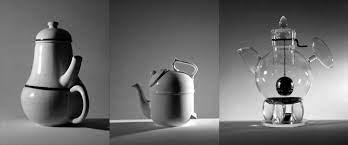
3 minute read
Curiosity Pag. 13
Meaning that everyone has their own thoughts and feelings that come with the experience. The use of people’s interaction can be a subtle way to let one create their own experience.
Donald Norman wrote numerous books about design. In Emotional Design he explains how important the value of our emotions are in relation to a product. He tells a story about three tea pots he owns; all are teapots, but they’re not all that useful. Picture. The least used teapot is the tilted one. ‘But’ explains Norman; “it has the best story behind it.” Which can be a reason to like the teapot more than the other two. Everyone has their own preferences within products. (see fig. 4)(Norman, Emotional Design: Why We Love (or Hate) Everyday Things 54) Do you have a favorite mock to drink from? Because it has a lot of volume? Or drinks lovely? Or does it have an emotional value? All good reasons to have a favorite product. My mock has a lovely touch, little texture but a smooth surface. Good comfortable handle to pick it up. Interaction is not only about emotions. The touch of an object is as important as the pull towards interacting.
Advertisement
After seeing the work of Anish Kapoor at the Venice Art Biennale I noticed that the works where appealing to be touched. Of course, you couldn’t touch them but still. It was attractive to do so. (see fig. 5)(“Anish Kapoor: Flashback”) Within this project I am creating the need that objects are to be touched and lifted. Appealing to be touched. According to the research of Northeastern University the behavior of touch is highly individual. The research was about how and when people touch certain objects. Through UV light the researchers could see where the object was touched the most.
Fig. 4, Teapots, 2005, Emotional Design by D. Norman

Fig. 5, Flashback by Anish Kapoor, 1980 - 1998, manchesterartgallery.org
2.3 Touch
(see fig. 6) By comparing surfaces, they saw that smooth surfaces are the most touched but to smooth is also seen as “expensive”, so people are also more cautious. Very spiky surfaces are the least favorite surfaces to touch. Everyone touches in their own way. Looking at their experiments they used a variety of objects and observed the way people touched the objects. (Rogowitz et al.)

Fig. 6, “Three-dimensional art objects and their touch patterns, revealed by fluorescent imaging. Results for the subtractive and additive method are shown. These methods reveal a range of touching, tracing, and grasping gestures, which are useful for exploring how humans interact with art and real-world objects.”
Rogowitz, Bernice, et al. “Touching Art.” Arxiv, IEEE VIS 2021, 1 Oct. 2021, arxiv.org/pdf/2110.00686.pdf.
Fig. 7, 8, 9, Spine Stool by Rene Siebum, 2013, Studio Rene Siebum, studiorenesiebum.nl/projects/spine-stool-48cm.
Seeing the touch of behavior makes clear that objects that which are smooth are way more frequently touched than rough surfaces. The intersection lies in between if you ask me. It is the balance between the rough and smooth surfaces that makes one touch a surface. A designer that does this in another way is Rene Siebum. He created a stool that interacts with your body on a very gentle and subtle way. Inspired by the human spine, he used the movement of the spine into the movement of the chair. Another method one can be invited to get an interaction with an object. (see fig. 7, 8, 9) (Rene Siebum)
Fig, 7 Fig, 8 Fig, 9







